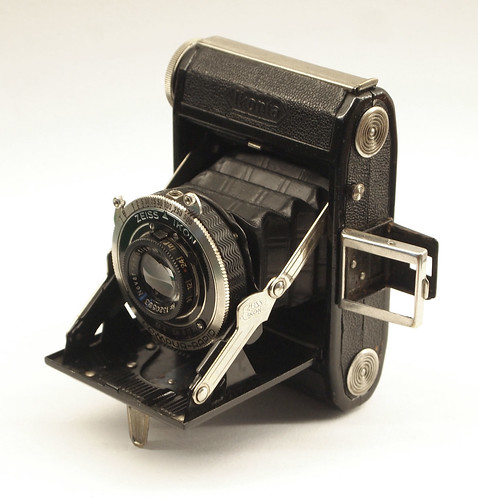 |
| Zeiss Ikon Ikonta 520/18 |
Having used my Zeiss Ikon Ikonta 520/18 - the
Baby Ikonta - for a number of the 127 Film Days over the past few years, I felt it was about time that I dedicated a short post to the camera itself. The reason for it becoming known as the 'baby' Ikonta is simply that it is a scaled down version of Zeiss Ikon's Ikonta 120 medium format cameras, specifically the Ikonta A 520 (the camera was also marketed as the Ikomat 520/18 in the US).
Zeiss Ikon appears to have been the manufacturer which devised the 3x4cm frame size on 127 film with the
Kolibri, which was first sold a year before the Ikonta 520/18. Previous cameras, such as the
Vest Pocket Kodak which introduced the
127 format rollfilm in 1912, used a frame size of 6x4cm; reducing this to a 'half frame' size meant squeezing twice as many pictures on a roll of film
and competing in size and convenience with the recent use of 35mm film in still cameras.
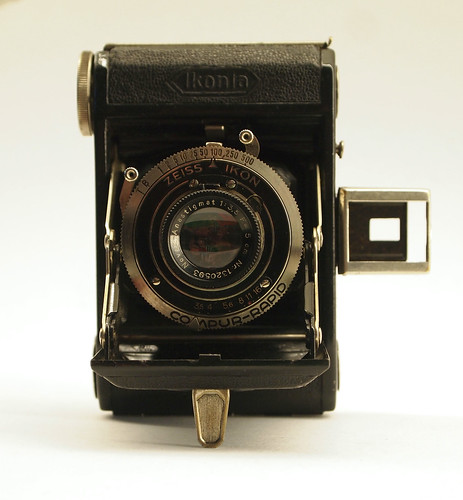 |
| Zeiss Ikon Ikonta 520/18 |
The Ikonta 520/18 was introduced in 1931 and was manufactured until around 1937. Like many cameras of its period it was available with a variety of lens and shutter combinations. My Baby Ikonta has a Compur-Rapid shutter and a Novar f3.5 lens; the top of the range has a Tessar lens, there are also Baby Ikontas with slower Novar lenses and
Telma shutters. The serial numbers on my camera date the lens to 1931, and the shutter to 1936. Looking at other examples online, some minor details of the design changed during the production run, but it remained essentially the same. Like most 3x4cm format 127 cameras, the focal length of the Ikonta 520/18 lenses are all 50mm, which gives a slight wide angle of view to the images. When folded the camera is comparable in size to a modern digital compact (see image below), easily pocketable, yet produces a negative around a third larger than the size of a standard 35mm frame.
 |
| Size comparison next to a carton of 35mm film |
As the Baby Ikonta uses the 3x4cm frame size, the camera shoots in a portrait orientation, 16 frames on a roll of 127 film. Designed for a image twice the size, 127 film has numbers on the backing paper to match, so the camera uses
two red windows: each number appears twice, once in each window (120 film originally had the same arrangement of backing numbers, but subsequently the numbers were rearranged on the paper to accommodate the three most common frame sizes, while 127 paper has just two rows of numbers for 6x4 and 4x4 frames). The Baby Ikonta is provided with a simple frame finder, and focus is by estimation. The lens focuses by front cell down to three feet, and the focus scale has a red spot half-way between 24 and 12 feet; this combines with a red spot between f8 and f11 on the aperture scale for a hyperfocal distance
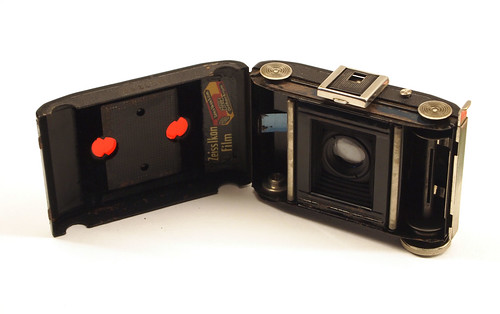 |
| Opened showing red windows and original film decal |
When I first shot a number of rolls of film with the camera, I noticed that despite 127 film backing paper having 8 numbers, Efke R100 film had 18 numbers in the film rebate, and quite a lot of film either end of the sequence of negatives. I found it quite easy to shoot a 17th frame on the Baby Ikonta, simply by an extra 3/4 turn on the winding knob after the final number on the paper backing: the winding knob has the words 'Made in Germany' on it to check its position, and looking at whichever letter is at 12 o'clock, I turned this to 9
o'clock to shoot a final frame. Having recently shot a roll of cut down medium format film for this January's 127 Day, there was enough film to get a full 18 frames.
 |
| Baby Ikonta with cut down Rollei RPX 400 |
The Ikonta 520/18 is a solidly made camera from Zeiss Ikon, constructed to precisely the same standards as the company's larger format cameras. Although a version with the Tessar lens would doubtless provide better quality images, the Novar on my camera does a fair job. I had until recently mostly used out of date film with the camera after Fotokemika's production of the last remaining 127 films shut down in 2012 but the possibility of using a wider range of films cut down from 120 format is very appealing.
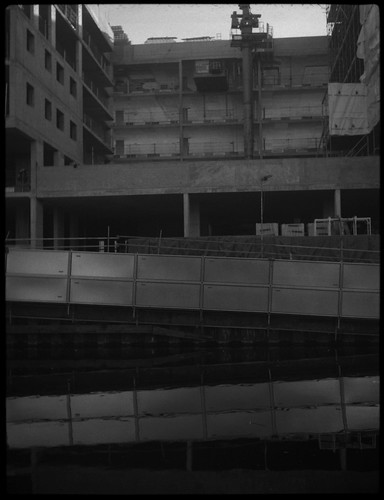 |
| Baby Ikonta with Efke R100 |
 |
| Baby Ikonta with Efke R100 pushed processed to 200 |
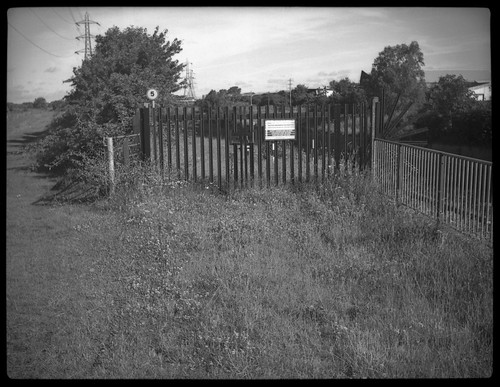 |
| Baby Ikonta with Agfa Retro 80S |
 |
| Baby Ikonta with Efke R21/R100, develop before date of August 1995 |
 |
| Baby Ikonta with Kodak Verichrome Pan, develop before date December 1981 |
 |
Baby Ikonta with Ilford FP4, develop before date December 1976
|
Sources/further reading:
Instruction manual as the Ikomat 520/18
Ikonta 520/18 on Collections Appareils











Thank you for this great write up! I know this is an old post but I just found one of these cameras at an estate sale and I was wondering if there is film somewhere now so that I could try it out? Its a fantastic little camera and it's just begging to be used I think.
ReplyDeleteIt's probably one of the best 127 cameras out there. Look for 'Rera Pan' or 'Reran' film online - unless you want to try cutting down 120 film yourself. I think there's also some colour film from Maco - branded Rollei that might still be available.
DeleteThanks for this! Helped me decide whether to purchase one or not...
ReplyDeleteTotally unrelated, but I was wondering: on the "Baby Ikonta with Efke R21/R100, develop before date of August 1995" picture, you've got a blochy sky. I myself have run into this problem quite frequently on different film stocks I've shot. Do you have any idea what it is due to? (Nobody around here seems to know...)
Hi - the blotchy sky is almost certainly a reaction between the film's emulsion and the backing paper - either the paper itself, or the printing on it - sometimes you can see the numbers showing up too.
DeleteThanks! I have one with the Compur shutter and Tesser lens.Also, one with a de-VAL shutter Which doesn't work Looking at your article. I need to use it again
ReplyDeleteThe one with the Tesser is an Ikomat. The other is an Ikonta
Delete